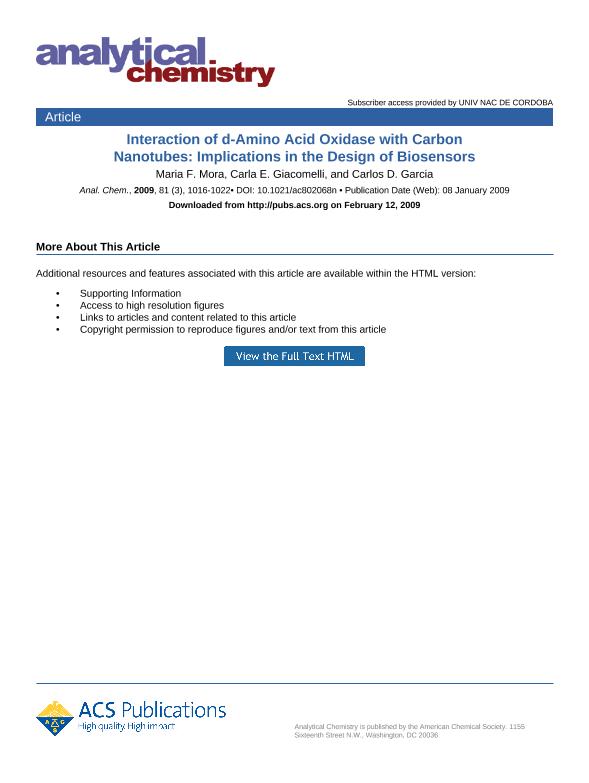Mostrar el registro sencillo del ítem
dc.contributor.author
Mora, Maria F.
dc.contributor.author
Giacomelli, Carla Eugenia

dc.contributor.author
Garcia, Carlos D.
dc.date.available
2020-09-14T19:03:01Z
dc.date.issued
2009-02
dc.identifier.citation
Mora, Maria F.; Giacomelli, Carla Eugenia; Garcia, Carlos D.; Interaction of D-amino acid oxidase with carbon nanotubes: Implications in the design of biosensors; American Chemical Society; Analytical Chemistry; 81; 3; 2-2009; 1016-1022
dc.identifier.issn
0003-2700
dc.identifier.uri
http://hdl.handle.net/11336/113965
dc.description.abstract
We have investigated the interaction of D-amino acid oxidase (DAAO) with single-walled carbon nanotubes (CNT) by spectroscopic ellipsometry. Dynamic adsorption experiments were performed at different experimental conditions. In addition, the activity of the enzyme adsorbed at different conditions was studied. Our results indicate that DAAO can be adsorbed to CNT at different pH values and concentrations by a combination of hydrophobic and electrostatic interactions. Considering that the highest enzymatic activity was obtained by adsorbing the protein at pH 5.7 and 0.1 mg·mL-1, our results indicate that DAAO can adopt multiple orientations on the surface, which are ultimately responsible for significant differences in catalytic activity. that DAAO can adopt multiple orientations on the surface, which are ultimately responsible for significant differences in catalytic activity. oxidase (DAAO) with single-walled carbon nanotubes (CNT) by spectroscopic ellipsometry. Dynamic adsorption experiments were performed at different experimental conditions. In addition, the activity of the enzyme adsorbed at different conditions was studied. Our results indicate that DAAO can be adsorbed to CNT at different pH values and concentrations by a combination of hydrophobic and electrostatic interactions. Considering that the highest enzymatic activity was obtained by adsorbing the protein at pH 5.7 and 0.1 mg·mL-1, our results indicate that DAAO can adopt multiple orientations on the surface, which are ultimately responsible for significant differences in catalytic activity. that DAAO can adopt multiple orientations on the surface, which are ultimately responsible for significant differences in catalytic activity. D-amino acid oxidase (DAAO) with single-walled carbon nanotubes (CNT) by spectroscopic ellipsometry. Dynamic adsorption experiments were performed at different experimental conditions. In addition, the activity of the enzyme adsorbed at different conditions was studied. Our results indicate that DAAO can be adsorbed to CNT at different pH values and concentrations by a combination of hydrophobic and electrostatic interactions. Considering that the highest enzymatic activity was obtained by adsorbing the protein at pH 5.7 and 0.1 mg·mL-1, our results indicate that DAAO can adopt multiple orientations on the surface, which are ultimately responsible for significant differences in catalytic activity. that DAAO can adopt multiple orientations on the surface, which are ultimately responsible for significant differences in catalytic activity. ·mL-1, our results indicate that DAAO can adopt multiple orientations on the surface, which are ultimately responsible for significant differences in catalytic activity.
dc.format
application/pdf
dc.language.iso
eng
dc.publisher
American Chemical Society

dc.rights
info:eu-repo/semantics/openAccess
dc.rights.uri
https://creativecommons.org/licenses/by-nc-sa/2.5/ar/
dc.subject
Biosensor
dc.subject
Adsorpiton Kinetics
dc.subject.classification
Físico-Química, Ciencia de los Polímeros, Electroquímica

dc.subject.classification
Ciencias Químicas

dc.subject.classification
CIENCIAS NATURALES Y EXACTAS

dc.title
Interaction of D-amino acid oxidase with carbon nanotubes: Implications in the design of biosensors
dc.type
info:eu-repo/semantics/article
dc.type
info:ar-repo/semantics/artículo
dc.type
info:eu-repo/semantics/publishedVersion
dc.date.updated
2019-03-18T14:42:10Z
dc.identifier.eissn
1520-6882
dc.journal.volume
81
dc.journal.number
3
dc.journal.pagination
1016-1022
dc.journal.pais
Estados Unidos

dc.journal.ciudad
Washington
dc.description.fil
Fil: Mora, Maria F.. University Of Texas At San Antonio.; Estados Unidos
dc.description.fil
Fil: Giacomelli, Carla Eugenia. Consejo Nacional de Investigaciones Científicas y Técnicas. Centro Científico Tecnológico Conicet - Córdoba. Instituto de Investigaciones en Físico-química de Córdoba. Universidad Nacional de Córdoba. Facultad de Ciencias Químicas. Instituto de Investigaciones en Físico-química de Córdoba; Argentina
dc.description.fil
Fil: Garcia, Carlos D.. University Of Texas At San Antonio.; Estados Unidos
dc.journal.title
Analytical Chemistry

dc.relation.alternativeid
info:eu-repo/semantics/altIdentifier/url/https://pubs.acs.org/doi/10.1021/ac802068n
dc.relation.alternativeid
info:eu-repo/semantics/altIdentifier/doi/http://dx.doi.org/10.1021/ac802068n
Archivos asociados
